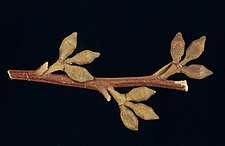Eucalyptus imlayensis
Eucalyptus imlayensis, commonly known as the Mount Imlay mallee,[2] is a species of small, straggly mallee that is endemic to the far south east of New South Wales, only occurring near the summit of Mount Imlay. It has mostly smooth bark, lance-shaped to curved adult leaves, flower buds in groups of three, white flowers and cup-shaped, bell-shaped or hemispherical fruit.[3]


| Mount Imlay mallee | |
|---|---|
| Stem of Eucalyptus imlayensis in Mount Imlay | |
| Scientific classification | |
| Kingdom: | Plantae |
| Clade: | Tracheophytes |
| Clade: | Angiosperms |
| Clade: | Eudicots |
| Clade: | Rosids |
| Order: | Myrtales |
| Family: | Myrtaceae |
| Genus: | Eucalyptus |
| Species: | E. imlayensis |
| Binomial name | |
| Eucalyptus imlayensis | |
Description
Eucalyptus imlayensis is a mallee that typically grows to a height of 7 m (23 ft) and forms a lignotuber. It has smooth bark that is shed in ribbons, curling over near the base. The bark is green when fresh, ageing to orange, brown then grey. Young plants and coppice regrowth have stems that are more or less square in cross-section with wings on the corners. Juvenile leaves are mostly arranged in opposite pairs, sessile, elliptic to egg-shaped, 40–75 mm (1.6–3.0 in) long and 15–30 mm (0.59–1.18 in) wide. Adult leaves are quite thick, veiny, lance-shaped or curved, the same glossy green on both sides, 75–150 mm (3.0–5.9 in) long and 15–30 mm (0.59–1.18 in) wide on a petiole 10–16 mm (0.39–0.63 in) long. The flower buds are arranged in leaf axils in groups of three on an unbranched peduncle 2–5 mm (0.079–0.197 in) long, the buds sessile. Mature buds are oval, 5–6 mm (0.20–0.24 in) long and 3–4 mm (0.12–0.16 in) wide with a conical to slightly beaked operculum. The fruit is a woody cup-shaped, bell-shaped or hemispherical capsule 4–5 mm (0.16–0.20 in) long and 6–7 mm (0.24–0.28 in) wide and sessile with a prominent disc and the valves protruding beyond the rim of the fruit.[2][4][5][6]
Taxonomy and naming
Eucalyptus imlayensis was first formally described in 1980 by Michael Crisp and Ian Brooker from a specimen collected on Mount Imlay in 1978 and the description was published in the journal Telopea. The specific epithet imlayensis is from the type location on Mount Imlay.[7][8]
This eucalypt is placed in the subgenus Symphyomyrtus, section Maidenaria, along with E. johnstonii, E. subcrenulata and E. vernicosa.[2]
Distribution and habitat
The Mount Imlay mallee grows in mossy shrubland dominated by tea tree on a steep quartzite outcrop and is only known from the Mount Imlay National Park. Other nearby species include the rare Imlay boronia, devil's twine, digger's speedwell, Tasmanian flax-lily, rasp fern, spiny-head mat-rush, scented paperbark, common shaggy pea and blotchy mint-bush. The ground layer is dominated by mosses. The soils are poor in nutrient, based from sandstone and conglomerate rocks.[9][10][11]
Conservation status
Eucalyptus imlayensis is listed as "endangered" under the Australian Government Environment Protection and Biodiversity Conservation Act 1999 and as "critically endangered" under the New South Wales Government Threatened Species Conservation Act 1995. The main threats to the species are its small population size in a single location, damage by gall-forming psyllids and lack of seedling recruitment. Dieback caused by the fungus Phytophthora cinnamomi and habitat modification caused by fire are potential threats. The population of mature trees was estimated to be about 80 in 2007.[10][11]
- Imlay Mallee with Devil's Twine
- Imlay Mallee
- base of an Imlay Mallee
- Mossy ground near the Imlay Mallee
References and further reading
- "Eucalyptus imlayensis". Australian Plant Census. Retrieved 28 July 2019.
- "Eucalyptus imlayensis". Euclid: Centre for Australian National Biodiversity Research. Retrieved 1 June 2020.
- G.Philips - NSW Herbarium
- A Field Guide to Eucalypts - Brooker & Kleinig volume 1, ISBN 0-909605-62-9 page 210
- Chippendale, George M. "Eucalyptus imlayensis". Flora of Australia. Australian Biological Resources Study, Department of the Environment and Energy, Canberra. Retrieved 28 July 2019.
- Hill, Ken. "Eucalyptus imlayensis". Royal Botanic Garden Sydney. Retrieved 28 July 2019.
- "Eucalyptus imlayensis". APNI. Retrieved 28 July 2019.
- Crisp, Michael D.; Brooker, M. Ian H. (1980). "Eucalyptus imlayensis, a new species from a mountain of south coastal New South Wales". Telopea. 2 (1): 41. Retrieved 28 July 2019.
- Floyd, Alexander G. (1990). Australian Rainforests in New South Wales. 2. Chipping Norton, Australia: Surrey Beatty & Sons with National Parks and Wildlife Service of New South Wales (published 1990-08-31). p. 150. ISBN 0-949324-32-9. Retrieved 2011-02-02. (other publication details, included in citation) (NOTE: this is a description of the rocks at the rainforest, 250 metres to the south)
- "Approved Conservation Advice for Eucalyptus imlayensis (Imlay Mallee)" (PDF). Australian Government Department of the Environment. Retrieved 28 July 2019.
- "Eucalyptus imlayensis - critically endangered species listing". New South Wales Government Office of Environment and Heritage. Retrieved 28 July 2019.
